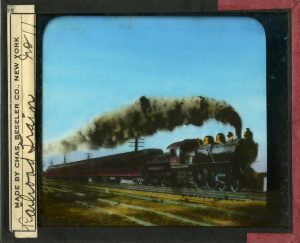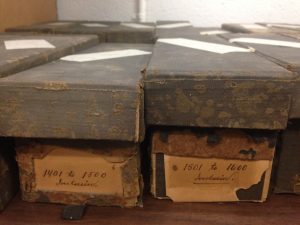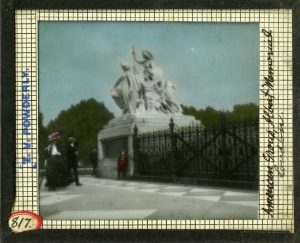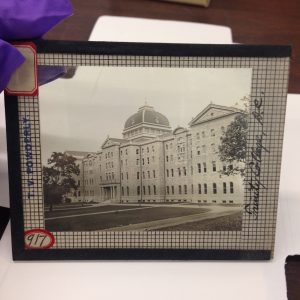
Author Katherine Santa Ana served as Graduate Library Pre-Professional (GLP), 2015-2017.
A treasure trove of almost 2,000 lantern slides belonging to labor leader Terence Vincent Powderly (1849-1924) resides in our Archive. These transparent glass slides, also referred to as “magic” lantern slides, are an eclectic mix of images taken by amateur photographer Powderly as well as commercially produced images he purchased. As a native of Carbondale, Pennsylvania, Powderly incorporated many images of creeks and mountains of the keystone state – as well as the occasional coal mine – into the collection. True to his roots as a leader of the Knights of Labor, many images of industrial technology are included, especially of locomotives. There are monuments and works of art from around the world, as well as personal portraits of the Powderly family at their home in the Petworth neighborhood of Washington D.C.
Short History of Lantern Slides
To get a handle on this collection, we first look to the history of the lantern slide format and how it was used. Photographic lantern slides appeared about a decade after the invention of photography in the mid-1800s, although projectable hand painted images existed long before. At about 3.25 x 4 inches, lantern slides are physically made up of a negative printed onto a sheet of glass as a positive, transparent image. The image could then be painstakingly hand colored or matted to achieve the desired effect. Next, an additional sheet of glass was placed over the transparency, creating a glass “sandwich” to protect the surface of the photograph. Finally, the two sheets of glass were taped together, and could be inserted into a magic lantern for projection and viewing.
Lantern slides were used for two purposes: entertainment and education. The primary purpose of our USCCB Lantern Slide Collection was educational, as they accompanied presentations detailing the National Catholic Welfare Conference’s work with veterans of the First and Second World Wars in the United States. The diversity and sheer number of slides in Powderly’s collection suggest he used his slides both for entertainment and educational purposes depending on the setting. While the family portraits could have been used as the equivalent of “family home videos,” the images of industry could have been part of his work with the Knights of Labor.

Additional information on the history of lantern slides:
- “About Lantern Slides,” University of South Florida Libraries Special Collections.
- “An Introduction to Lantern History,” The Magic Lantern Society.
Taking Inventory
At some point prior to the arrival of the slides at the Archives in 2009, someone attempted to reorder the collection into simple thematic groups, such as “Stone Monuments,” “D.C. and World” and “People.” In the archival world, “respect des fonds” (preserving the original order of a group of records), is an important and fundamental principle. Often, the original order shows relationships and provides insight into how the records were accessed and used. Presumably, Powderly had his own numbered list so he could easily keep track of his collection. Since we do not have this original master list, we will be reconstructing it as we process this large collection. Going through each of the slides, we will record basic information such as the slide number and title. This is also a good time to take note of any damage the slides might have sustained.

Rehousing
After completing the list, if we find it is more valuable for researchers to have the slides in the original order, we will reorganize them to match Powderly’s original intent. When handling the slides, we wear powder-free nitrile gloves to protect the images from fingerprints and hand oils. During this phase, we will also remove the slides from their crumbling containers and place them in archival, acid free boxes. Before doing so, each lantern slide will be carefully enfolded in a four-flap envelope to protect the surface of the image. Lantern slides are surprisingly heavy, so we place no more than 70 slides in a small box. Even then, these boxes are like bricks! As of this writing, we are a little under half way through rehousing the slides.
Additional information on the housing of lantern slides:
- “Housing – Mira Dock Forestry Lantern Slides Collection: Procedures for Cleaning and Housing Glass Lantern Slides,” Penn State University Libraries.
- “Conserve O Gram: Caring for Photographs, Special Formats,” National Park Service, June 1997.
Digitizing
Once a collection is organized and rehoused, the next question is to determine whether or not to digitize. Some questions to ask before choosing to digitize could include: Are these materials unique? Will digitization promote access to these materials? Will digitization help preserve the collection? In our case, digitization is not a high priority as many of the same images have already been scanned from prints available through the Terence Vincent Powderly Photographic Prints Digital Collection. However, should we choose to pursue digitization, many wonderful resources are available online to guide us through the process.

Additional information on the digitization of lantern slides:
- “Digitizing Lantern Slides in the Warren H. Manning Collection,” Bill Yungclas and Melissa Tedone of Iowa State University, 2011.
- “Digitizing – Mira Dock Forestry Lantern Slides Collection: Digitization Process – Scanning & Storing the Slides,” Penn State University Libraries.
Last Thoughts
Lantern slides are an interesting format with a rich history and a few special concerns, such as sensitivity to light, fragility, heavy weight, and need of specific housing materials. By taking a systematic approach to the various steps of the project, our large collection belonging to Terence Vincent Powderly will continue to be organized and rehoused as time and resources permit. For additional information about the life and times of amateur photographer, slide maker, labor leader, and former mayor of Scranton T.V. Powderly, check out the finding aid of his manuscript collection.
